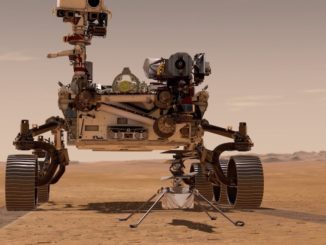
China has performed a hover and hazard avoidance test on a model the country’s first Mars rover, while engineers ready the real spacecraft for launch toward the red planet in mid-2020.
Comprising an orbiter, lander and rover, the mission aims to become the first Chinese spacecraft to reach Mars after lifting off aboard a Long March 5 rocket — the country’s most powerful launcher — during a several week window opening in July 2020.
The mission will launch from the Wenchang space center on Hainan Island, China’s newest spaceport.
China invited ambassadors and envoys from 19 countries, including the European Union, the African Union, France, Italy and Brazil, to visit a test rig in northern China’s Hebei province Nov. 14 to view a ground test of the Mars lander. The demonstration tested the rover’s ability to hover and autonomous avoid obstacles during descent under reduced gravity conditions, similar to those on Mars, according to the China National Space Administration.
Billed by China as the public unveiling of the Mars mission, the event last week verified the lander’s design, the Chinese space agency said.
If it launches next summer, the mission will reach Mars in early 2021 and release the landing module to enter the Martian atmosphere. After landing, the rover will drive off a ramp to begin exploring the surface with a suite of scientific instruments.
The orbiter will circle Mars to provide communications relay support for the rover and conduct its own scientific measurements.
The orbiting module carries high- and medium-resolution cameras, a radar instrument to probe the structure of the Martian subsurface, a spectrometer to analyze minerals in the Martian crust, and sensors to collect data on the interaction between the red planet’s tenuous magnetosphere and the solar wind.
Designed for three months of operation after arrival on Mars, the rover carries its own cameras and a radar to study underground layers below the mission’s landing site, along with a spectrometer and a Mars weather station, according to the National Space Science Center at the Chinese Academy of Sciences.

China kicked off development of the Mars mission in 2016.
It will be the country’s second attempt to reach Mars with a robotic probe, following the Yinghuo 1 orbiter, which was stranded in Earth orbit after launch as a piggyback payload on Russia’s failed Phobos-Grunt mission.
China has landed two robotic spacecraft on the moon, and plans to launch a third lunar lander next year to attempt the first lunar sample mission in more than 40 years.
Like the Mars mission, the Chang’e 5 lunar sample return mission will launch on the Long March 5, one of the most powerful rockets in the world, and the heaviest in China’s inventory of launch vehicles.
While the Mars orbiter and rover launching next year will carry exclusively Chinese payloads, officials used the Nov. 14 test to herald the country’s cooperation with other countries on space projects.
According to a CNSA statement, China has signed more than 140 space cooperation agreements with 45 countries and international organizations.
The China-France Oceanography Satellite and the China Seismo-Electromagnetic Satellite were launched by China last year in partnership with scientists from France and Italy, respectively, to collect climate measurements and detect precursor signals that could help predict earthquakes. China has developed a series of Earth observation satellites in cooperation with Brazil, and Germany, the Netherlands, Sweden and Saudi Arabia contributed to China’s Chang’e 4 lunar mission.
China has invited international proposals for small science instruments that could fly to the moon on the Chang’e 6 robotic mission in 2023. Earlier this month, Chinese and French space officials signed an agreement to fly a French instrument on the Chang’e 6 mission to measure the transport of volatiles, such as water molecules, in lunar dust.
Email the author.
Follow Stephen Clark on Twitter: @StephenClark1.



